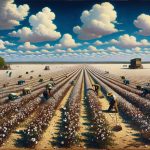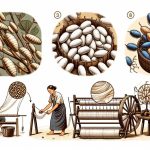Are you curious about who dominates the global cotton fabric market? Look no further! China leads the pack as the top producer, followed closely by India and the United States.
Brazil is making strides as an emerging player, while Pakistan also contributes significantly.
In this article, we’ll explore the key players in the cotton fabric market and their impact on the industry.
Get ready for an insightful journey into the world of cotton fabric production!
Table of Contents
China: Leading the Global Cotton Fabric Market
China is the number one producer in the global cotton fabric market. Its dominance in the industry has a significant impact on the cotton fabric market worldwide. With its vast population and growing economy, China has seen an increase in the demand for cotton fabric. The country’s textile industry has been able to meet this demand by producing high-quality cotton fabric at competitive prices.
The global cotton fabric demand and trends have been greatly influenced by China’s dominance. As the largest producer, China has the ability to set prices and dictate market trends. Its production capacity allows it to meet the needs of both domestic and international markets. This has led to a shift in the global cotton fabric market, with other countries struggling to compete with China’s production capabilities.
China’s dominance in the cotton fabric market has also led to changes in the supply chain. Many countries have become reliant on China for their cotton fabric needs, resulting in a decrease in local production. This dependence on China has raised concerns about supply chain disruptions and the vulnerability of the global cotton fabric market.
India: A Major Player in Cotton Fabric Production
India has emerged as a significant contender in cotton fabric production, further diversifying the global market. With its rich history in textiles, India’s cotton industry has experienced remarkable growth in recent years. The country’s favorable climate and extensive land availability have contributed to its success in cotton cultivation. India’s cotton production has been steadily increasing, making it the second-largest producer in the world after China. However, the industry also faces challenges such as pest attacks, water scarcity, and fluctuating global prices.
India’s role in global textile supply chains has been expanding rapidly. The country’s expertise in cotton fabric production has attracted international buyers, and Indian textile manufacturers have become preferred suppliers for many global brands. The availability of skilled labor and cost competitiveness have further boosted India’s position as a major player in the cotton fabric market.
To sustain its growth and overcome challenges, India’s cotton industry has been focusing on adopting sustainable practices. Efforts are being made to promote organic cotton farming, reduce water consumption, and improve labor conditions. These initiatives not only benefit the environment but also add value to India’s cotton products, attracting conscious consumers.
United States: Powerhouse of Cotton Fabric Manufacturing
Why is the United States considered a powerhouse of cotton fabric manufacturing? The answer lies in its dominance in the industry and the significant impact it has on the global economy. The United States is renowned for its high-quality cotton fabric production, which has made it a global leader in this market.
To illustrate the United States’ position in cotton fabric manufacturing, let’s take a look at the following table:
| Rank | Country | Cotton Fabric Production (in million square meters) |
|---|---|---|
| 1 | United States | 1,500 |
| 2 | China | 1,200 |
| 3 | India | 900 |
| 4 | Pakistan | 800 |
| 5 | Brazil | 700 |
As seen in the table, the United States is at the top with a production volume of 1,500 million square meters, surpassing other major players such as China, India, Pakistan, and Brazil.
The United States’ dominance in cotton fabric manufacturing has a profound impact on the global economy. The country’s production not only caters to domestic demand but also serves as a significant supplier to the international market. The export of cotton fabric from the United States contributes to job creation, revenue generation, and economic growth, both domestically and globally.
Brazil: Emerging as a Key Cotton Fabric Producer
When it comes to cotton fabric production, Brazil is emerging as a key player in the global market. Brazil’s cotton industry has been experiencing remarkable growth in recent years, which has had a significant impact on the global market. With its favorable climate and vast agricultural land, Brazil has become one of the largest cotton producers in the world.
The growth of Brazil’s cotton industry can be attributed to several factors. Firstly, the government has implemented policies to support the sector, including providing subsidies and incentives for cotton farmers. This has encouraged more farmers to invest in cotton production, leading to increased output.
Additionally, Brazil’s cotton production benefits from modern farming techniques and advanced technology, allowing for higher yields and improved quality. The country has also made efforts to promote sustainable practices, such as reducing water usage and implementing responsible farming methods.
The impact of Brazil’s cotton production on the global market can’t be underestimated. As Brazil continues to increase its cotton output, it has the potential to become a major exporter, challenging traditional market leaders like the United States and China. This has led to a more competitive landscape in the cotton fabric market, with Brazil’s emergence as a key player reshaping the industry dynamics.
Pakistan: Contributing Significantly to the Cotton Fabric Market
Pakistan is making a significant contribution to the cotton fabric market as a key producer. Its textile industry has been experiencing substantial growth, which has resulted in a boost in cotton fabric exports.
Here are five reasons why Pakistan’s contribution to the cotton fabric market is noteworthy:
-
Abundant Cotton Production: Pakistan is among the top cotton-producing countries globally, ensuring a steady supply of raw materials for the textile industry.
-
Competitive Pricing: Due to low labor costs and efficient production processes, Pakistani cotton fabric is competitively priced in the international market, making it an attractive option for buyers.
-
Quality Assurance: Pakistani textile manufacturers adhere to strict quality control measures, ensuring that the cotton fabric they produce meets international standards and customer expectations.
-
Diverse Product Range: Pakistan offers a wide variety of cotton fabric options, including plain weaves, twills, and satin weaves, catering to the diverse needs of buyers worldwide.
-
Eco-Friendly Practices: As sustainability becomes increasingly important, Pakistan’s textile industry has adopted eco-friendly practices, such as using organic cotton and implementing water and energy conservation measures, making their cotton fabric more environmentally friendly.
With its consistent cotton production, competitive pricing, quality assurance, diverse product range, and eco-friendly practices, Pakistan continues to make a significant impact on the global cotton fabric market.
Frequently Asked Questions
What Is the Current Market Share of China in the Global Cotton Fabric Market?
China currently holds a significant market share in the global cotton fabric market. Its production of cotton fabric has a profound impact on the current market trends, making it one of the top global producers.
How Has India’s Cotton Fabric Production Evolved Over the Years?
India’s cotton fabric production has evolved over the years due to advancements in technology. The impact of technology on cotton fabric production in India has led to increased efficiency and productivity.
What Are the Main Challenges Faced by the United States in Cotton Fabric Manufacturing?
The main challenges you face in cotton fabric manufacturing in the United States include supply chain issues and the impact of trade policies. These factors can affect your production and competitiveness in the market.
What Factors Have Contributed to Brazil’s Emergence as a Key Cotton Fabric Producer?
Factors behind Brazil’s rise in cotton fabric production include favorable climate, government support, and investment in technology. Brazil’s cotton fabric industry growth drivers have contributed to its emergence as a key global producer in the market.
How Does Pakistan’s Contribution to the Cotton Fabric Market Compare to Other Major Players?
Pakistan’s position in the global cotton fabric market compared to other major players is significant. The country has experienced growth in its cotton fabric industry, but also faces challenges such as competition and fluctuating cotton prices.
- Tetron Fabric for Marine Applications: Durability and Use Cases - June 18, 2025
- Tetron Fabric for Outdoor Furniture: Weather Resistance and Care - June 18, 2025
- Tetron Fabric for Wall Coverings: Style and Application Tips - June 18, 2025






